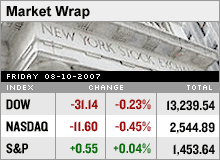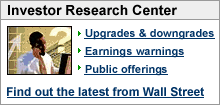Wall Street: Down but not outMajor gauges cut losses but still end in the red for day 2 as investors weigh Fed's $38 billion infusion into the banking system. Worries remain about tightening credit, subprime mortgage market.NEW YORK (CNNMoney.com) -- Stocks fell Friday, but recovered from bigger losses earlier in the session after the Federal Reserve pumped $38 billion into the banking system, soothing some worries about tightening credit and the subprime mortgage market fallout. Treasury bond prices fell, raising the corresponding yields. Oil prices dipped, and gold prices rebounded. The Dow Jones industrial average (up 56.25 to 13,295.79, Charts) lost 0.2 percent, after falling more than 200 points in the morning. On Thursday, the Dow slumped 387 points, suffering its second biggest one-day point and percentage decline of the year. The broader S&P 500 (up 6.46 to 1,460.10, Charts) index ended little changed, recovering from earlier losses, while the tech-fueled Nasdaq Composite (up 7.60 to 2,552.49, Charts) index gave up 0.5 percent after falling more in the morning. All three major gauges managed to end modestly higher for the week, with a three-day rally in the first half of the week trumping Thursday's battering and Friday's mixed trade. For the week, the Dow gained about 0.4 percent, the S&P 500 rose 1.4 percent and the Nasdaq composite added 1.3 percent. The volatile nature of trading is unlikely to ease up anytime soon, said Randy Diamond, an equity trader at Miller Tabak. However, "If this thing continues to play out as it has on a daily basis, people may become less jumpy," he said. "Eventually, the market will have to pick a direction and go with it - but it's too hard to tell now which way it will go." Next week brings a bevy of key readings on the economy, including the July retail sales and June business inventory reports on Monday. The Dow had slumped more than 200 points in the morning, reflecting a broad market selloff, before trying to rebound near midday after the second wave of the Federal Reserve's cash infusion. The afternoon was again choppy, as investors struggled to position themselves amid ongoing uncertainty. Treasury bond prices fell, after having risen in the morning in a classic "flight-to-quality" move into the comparatively safer haven of bonds. Stocks slumped Thursday as worries about a tightening of the global credit market resurfaced, sparking a broad decline in stocks in the U.S. and abroad. The worries continued Friday after central banks in Europe, Japan, Australia and the U.S. all made billions available. However, investors found some solace in news later in the session that the U.S. Federal Reserve had upped its initial influx of $19 billion to first $35 billion and then $38 billion, said Joseph Saluzzi, co-head of equity trading at Themis Trading. "There may be a little less fear now," Saluzzi said. "It may not really make much of a difference, but it settles some feelings." Yet, concerns about credit tightening and subprime aren't going away anytime soon, and the market is bound to remain vulnerable in the weeks ahead, let alone next week. "This is still an emotional market and there are a lot of news events that could happen over the weekend that could weigh on stocks next week," Saluzzi said. Earlier in the week, French bank BNP Paribas said it was halting withdrawals from three of its funds because of current market conditions, while Goldman Sachs (Charts, Fortune 500) said two of its hedge funds have sold some of their positions because of recent losses. Similar news from other financial institutions this weekend or early next week could spark another leg down for the stock market, Saluzzi said. Stocks have been whipsawed over the last few months on fears about tightening credit after a period of widespread liquidity. At the same time, investors have been trying to sort out the implications of the fallout from the subprime mortgage market - loans made to consumers with less than ideal credit - amid the slumping housing market. The European Central Bank (ECB) pumped extra cash into the system for a second day in a row, adding $83 billion in liquidity Friday. Central banks in Japan and Australia also added liquidity to their banking systems. The Federal Reserve followed suit, initially adding $19 billion in temporary reserves. The move was the biggest single temporary open market operation in four years, the New York Federal Reserve said. In the late morning, the central bank said it was adding an additional $16 billion and in the afternoon, another $3 billion, bringing the total to $38 billion. Futures markets show traders expect the Federal Reserve to cut interest rates on Sept. 18, the next policy meeting. However, there is also some speculation that the central bank could cut rates ahead of that meeting. Select commodity and technology stocks bounced back, enabling the broader market to trim losses. Gold and silver prices rose, boosting a variety of metal and mining stocks. The Amex Gold Bugs (down $2.81 to $343.21, Charts) index jumped 2 percent. Among Dow 30 stocks, Exxon Mobil (down $0.56 to $83.95, Charts, Fortune 500) and IBM (up $0.96 to $113.60, Charts, Fortune 500) managed gains, while Alcoa (up $1.20 to $35.89, Charts, Fortune 500), General Electric (up $0.09 to $38.32, Charts, Fortune 500) and Microsoft (down $0.02 to $28.69, Charts, Fortune 500) all declined. Countrywide Financial (down $0.89 to $26.82, Charts, Fortune 500) slipped almost 3 percent after saying in a regulatory filing that unprecedented disruptions in the mortgage market pose a threat to its financial state. Market breadth was negative, but improved from the morning. On the New York Stock Exchange, decliners beat advancers 5 to 3 on volume of 2.52 billion shares. On the Nasdaq, losers topped winners 9 to 7 on volume of 3.23 billion shares. Treasury prices fell, lifting the benchmark 10-year note yield to 4.80 percent from 4.77 percent late Thursday. Bond prices and yields move in opposite directions. In currency trading, the dollar slipped versus the euro and rose versus the yen. U.S. light crude oil for September delivery fell 12 cents to $71.47 a barrel on the New York Mercantile Exchange. |
|




